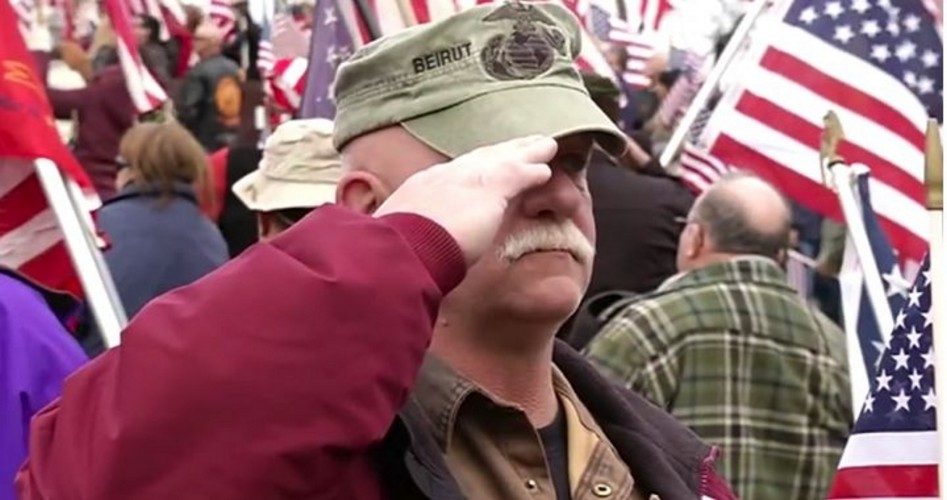
After college officials removed the U.S. flag from the main flagpole on campus after the election of Donald Trump, Hampshire College — located in Amherst, Massachusetts — was the site of a peaceful demonstration of about 400 veterans and flag supporters on Sunday afternoon.
The decision of the college to remove the flag was seen as offensive to those who respect that flag as a symbol of America. It also reveals ignorance of the fact that more than 90 percent of the very students who claim to have felt “deep fear” of that flag and what it stands for (having grown up “in marginalized communities, never feeling safe,” according to a statement by the college’s president, Jonathan Lash) are receiving federal financial aid to attend Hampshire College.
According to the college’s website, “For some students, Hampshire is more affordable than a public institution.” (Emphasis in original.) Furthermore, according to the same website, 91 percent of the roughly 1,400 students at Hampshire are receiving financial aid. The tuition, room, and board at the college is $60,570 per year. The average financial aid package is $40,087. Perhaps that explains the fact that the college is “more affordable than a public institution.” What it does not explain is what those students — many of whom are receiving scores of thousands of dollars in federal grants and federally subsidized student loans to attend the college — have to be angry about concerning the flag of their “benefactor” flying over the campus. While federal programs for grants and loans for college students have no constitutional justification for existing in the first place (and should, therefore, be abolished), the fact is that they do exist. And in this case those who benefit from them are the very ones who demanded the removal of the flag.
Here’s a tip for those students who feel “deep fear” because of the flag while cashing checks from the federal government: You will never slay a beast while you suckle at its teat.
While the college’s decision to remove the flag is both offensive and ignorant, it is not surprising to anyone who has been connecting the dots over the past few years and especially over the past few months.
After all, the same vitriol has been being directed at the Confederate battle flag — seen by many as a symbol of racism since the party line is that the southern states seceded over the single issue of slavery. In reality, the South seceded over a litany of issues regarding states’ rights. In the modern battle over states’ rights, the Left has sought to remove all memory of the flags of the Confederacy, which — still today — stand as symbols of resistance to any tyranny over the rights of states and individuals. In this regard, the Gadsden flag (“Don’t Tread On Me”) is no different, as any Tea Party can attest.
Given that the most frequent complaint against any flag associated with the Confederate States of America is that it symbolizes racism (a statement that is historically ignorant), it should come as no surprise to see the American flag (which many on the Left say is also a symbol of racism) coming under similar attack.
Consider the recent protests of the national anthem, the “Star Spangled Banner,” which is about the U.S. flag. While San Francisco 49ers quarterback Colin Kaepernick may have only “kicked off” the protests, other athletes were quick to grab the ball and run with it. As Steve Byas reported in August, Shaun King — famous for his left-leaning and race-baiting blog — wrote for the New York Daily News about Kaepernick’s refusal to stand for the anthem, saying, “We must do away with [the national anthem] like South Carolina did with the Confederate Flag over their state house.” It is of little use to attack the anthem without attacking the flag it praises and reveres. Since the Left’s hatred of the song stems from its hatred of the flag — which in turn stems from its hatred of America — one could easily have expected the American flag itself to come under attack. As Byas also wrote in that article:
King’s comments were a full-throated endorsement of the decision of San Francisco 49er quarterback Colin Kaepernick … to protest the song, by refusing to stand during its presentation at a recent pre-season game of the National Football League. Asked later why he would not stand for the playing of the national anthem, Kaepernick responded, “I am not going to stand up to show pride in a flag for a country that oppresses black people.”
At the time of the recent controversy over the removal of the Confederate Flag in South Carolina, many warned that attacks upon such symbols would not stop at Confederate emblems, but would soon include efforts to remove other signs of American heritage not connected at all with the Confederate States of America. The Confederate “battle flag” had nothing to do with slavery, and Abraham Lincoln did not call for 75,000 volunteers to abolish slavery; he called them up to keep 11 southern states from seceding. After all, slavery remained legal under the flag of the United States until the passage of the 13th Amendment in 1865.
So, the attack on the U.S. flag — and by extension, on America — is no new development. As The New American’s Warren Mass wrote last year when students at Ole Miss removed the state flag because it has — in the upper left corner — the Confederate battle flag:
[Radio commentator Rush] Limbaugh predicted that the progressives’ next target would be the U.S. flag, which he says symbolizes a country that those on the Left do not like. Furthermore, he is not optimistic that Republican politicians will fight for the American flag when that attack comes.
At Hampshire College, students at first lowered the U.S. flag to half mast in the days after Trump’s election. While those students may have felt a sense of mourning and a need for a “safe place” to deal with their shock and grief, the flag at half mast is a sign of a nation in mourning, not a campus in shock. Next, some of those students burned the flag. President Lash said, “If it was a political act, it was pretty craven and ineffective since people did it in secret and no one knows what it was meant to state.” The college replaced the flag the next day. But within a week, the college — in an effort to calm the fears of students — removed the flag.
If the leadership (if those who follow the emotional whims of the students can be called “leaders”) of the college expected that angry, scared millennials are the only ones who know how to organize a demonstration, they were mistaken. A group of military veterans used Facebook and other tools to organize a demonstration at the college to make their voices heard. In contrast to the “Not My President” crowd, these veterans and their supporters — numbering about 400 —gathered peacefully on the college green and waved American flags while having a good time. They didn’t burn anything or attack anyone. They didn’t threaten. They didn’t disrupt. They simply demonstrated peacefully in support of the flag which many of them saw brothers-in-arms die to serve and defend. Their chant — seen in a video posted to the Internet — was positive: “Raise our flag!”
Whether their voices will be heard remains to be seen. President Lash — who is the son of a WWII veteran — appears to have at least sipped from the poisoned well of liberalism. He told the New York Times that he attended the veterans’ demonstration and thought it was fun and patriotic, but is able to “maintain both ideas [that the flag is a symbol of patriotism and a fearful symbol of racist oppression] in my heart at the same time.”
Whatever happens at Hampshire College, the fight for American heritage — and the American spirit — is far from over.




